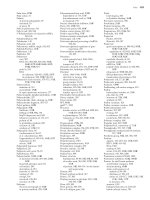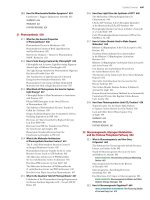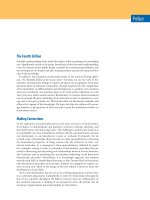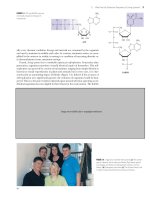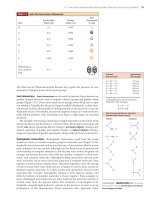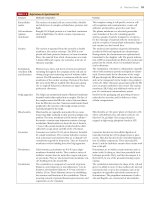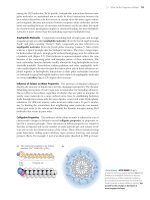Biochemistry, 4th Edition P1 pptx
Bạn đang xem bản rút gọn của tài liệu. Xem và tải ngay bản đầy đủ của tài liệu tại đây (562.53 KB, 10 trang )
Physical Constants
Name Symbol SI Units cgs Units
Avogadro’s number N 6.022137 ϫ 10
23
/mol 6.022137 ϫ 10
23
/mol
Boltzmann constant k 1.38066 ϫ 10
Ϫ23
J/K 1.38066 ϫ 10
Ϫ16
erg/K
Curie Ci 3.7 ϫ 10
10
d/s 3.7 ϫ 10
10
d/s
Electron charge e 1.602177 ϫ 10
Ϫ19
coulomb† 4.80321 ϫ 10
Ϫ10
esu
Faraday constant Ᏺ 96485 J/V и mol 9.6485 ϫ 10
11
erg/V и mol
Gas constant* R 8.31451 J/K и mol 8.31451 ϫ 10
7
erg/K и mol
Gravity acceleration g 9.80665 m/s
2
980.665 cm/s
2
Light speed (vacuum) c 2.99792 ϫ 10
8
m/s 2.99792 ϫ 10
10
cm/s
Planck’s constant h 6.626075 ϫ 10
Ϫ34
J и s 6.626075 ϫ 10
Ϫ27
erg и s
*Other values of R: 1.9872 cal/K и mol ϭ 0.082 liter и atm/K и mol.
†1 coulomb ϭ 1 J/V.
Conversion Factors
Pressure: 1 atm ϭ 760 torr ϭ 14.696 psi
1 torr ϭ 1 mm Hg
Temperature: K ϭ °C ϩ 273
C ϭ (5/9)(°F Ϫ 32)
Volume: 1 liter ϭ 1 ϫ 10
Ϫ3
m
3
ϭ 1000 cm
3
Energy: 1 Joule ϭ 10
7
ergs ϭ 0.239 cal
1 cal ϭ 4.184 Joule
Length: 1 nm ϭ 10 Å ϭ 1 ϫ
Ϫ7
cm
Mass: 1 kg ϭ 1000 g ϭ 2.2 lb
1 lb ϭ 453.6 g
Useful Equations
The Henderson–Hasselbalch Equation
pH ϭ pK
a
ϩ log([A
Ϫ
]/[HA])
The Michaelis–Menten Equation
v ϭ V
max
[S]/(K
m
ϩ [S])
Temperature Dependence of the Equilibrium Constant
⌬H ° ϭϪRd(ln K
eq
)/d(1/T)
Free Energy Change under Non-Standard-State Conditions
⌬G ϭ ⌬G ° ϩ RT ln ([C][D]/[A][B])
Free Energy Change and Standard Reduction Potential
⌬G °ЈϭϪnᏲ⌬ᏱЈ
°
Reduction Potentials in a Redox Reaction
⌬ᏱЈ
°
ϭ ⌬ᏱЈ
°
(acceptor) Ϫ ᏱЈ
°
(donor)
The Proton-Motive Force
⌬p ϭ ⌬⌿ Ϫ (2.3 RT/Ᏺ)⌬pH
Passive Diffusion of a Charged Species
⌬G ϭ G
2
Ϫ G
1
ϭ RT ln(C
2
/C
1
) ϩ ZᏲ⌬⌿
The Standard Genetic Code
AAA Lysine CAA Glutamine GAA Glutamate UAA stop
AAC Asparagine CAC Histidine GAC Aspartate UAC Tyrosine
AAG Lysine CAG Glutamine GAG Glutamate UAG stop
AAU Asparagine CAU Histidine GAU Aspartate UAU Tyrosine
ACA Threonine CCA Proline GCA Alanine UCA Serine
ACC Threonine CCC Proline GCC Alanine UCC Serine
ACG Threonine CCG Proline GCG Alanine UCG Serine
ACU Threonine CCU Proline GCU Alanine UCU Serine
AGA Arginine CGA Arginine GGA Glycine UGA stop
AGC Serine CGC Arginine GGC Glycine UGC Cysteine
AGG Arginine CGG Arginine GGG Glycine UGG Tryptophan
AGU Serine CGU Arginine GGU Glycine UGU Cysteine
AUA Isoleucine CUA Leucine GUA Valine UUA Leucine
AUC Isoleucine CUC Leucine GUC Valine UUC Phenylalanine
AUG Methionine* CUG Leucine GUG Valine UUG Leucine
AUU Isoleucine CUU Leucine GUU Valine UUU Phenylalanine
*AUG also serves as the principal initiation codon.
CengageNOW
™
will help you:
Ǡ
Create a Personalized Study plan for each chapter
of this text.
Ǡ
Explore biochemistry concepts through tutorials,
simulations, and animations.
Ǡ
View Active Figures and interact with text illustrations.
These Active Figures will help you master key concepts
from the book. Each gure is paired with correspond-
ing questions to help you focus on biochemistry at
work to ensure that you understand the concepts
played out in the animations.
Ǡ
Better prepare for exams and increase your chances
of success.
How can you gain access to CengageNOW?
If the access code card was not ordered with your text, or you have a used version of the text, you can purchase access
to this remarkable program for a nominal fee. Just visit www.ichapters.com where easy-to-follow instructions will help
you purchase an instant access code.
Completely integrated with this text!
www.cengage.com/tlc
Set your sights on success
in biochemistry
with this
interactive personal
assessment tool
Make the most of your study time—log on to CengageNOW today!
www.cengage.com/tlc
CengageNOW
™
is web-based,
powerful and interactive!
This dynamic resource will help you gauge your own unique
study needs. Then, the program generates a Personalized Study
plan that will help you focus your study time on the concepts
you most need to master. You will quickly begin to optimize
your study time and get one step closer to success.
Icons and Colors in Illustrations
The following symbols and colors are used in this text to help in illustrating structures,
reactions, and biochemical principles.
Inorganic phosphate and pyrophosphate are sometimes symbolized by the following icons:
Elements:
Sugars:
Nucleotides:
Amino acids:
Enzymes:
= Oxygen
= Nitrogen = Phosphorus = Sulfur = Chlorine= Carbon
= Adenine= Cytosine= Guanine = Thymine = Uracil
= Non-polar/hydrophobic = Basic = Polar/uncharged = Acidic
Glucose RiboseFructoseMannoseGalactose
P
Inorganic phosphate (P
i
)
Pyrophosphate (PP
i
)
P
P
= Enzyme activation
= Enzyme inhibition or inactivation
= Enzyme = Enzyme Enzyme names are printed in red.
+
Phosphoryl group
These colors are internally consistent within reactions and are generally consistent
within the scope of a chapter or treatment of a particular topic.
Red arrows are used to indicate nucleophilic attack.
Some examples:
P
–
O
–
O
O
Hydroxyl group
OH
Amino group
NH
3
+
Carboxyl group
COO
–
In reactions, blocks of color over parts of molecular structures are used so that discrete parts of the
reaction can be easily followed from one intermediate to another, making it easy to see where the
reactants originate and how the products are produced.
E
Biochemistry
FOURTH EDITION
Reginald H.Garrett • Charles M.Grisham
University of Virginia
With molecular graphic images
by Michal Sabat,University of Virginia
Australia • Brazil • Japan • Korea • Mexico • Singapore • Spain • United Kingdom • United States
Biochemistry, Fourth Edition
Reginald H. Garrett, Charles M. Grisham
Publisher: Mary Finch
Senior Acquisitions Editor: Lisa Lockwood
Senior Development Editor: Sandra Kiselica
Assistant Editor: Ashley Summers
Editorial Assistant: Elizabeth Woods
Senior Media Editor: Lisa Weber
Marketing Manager: Amee Mosley
Marketing Assistant: Kevin Carroll
Marketing Communications Manager: Linda Yip
Project Manager, Editorial Production:
Teresa L. Trego
Creative Director: Rob Hugel
Art Director: John Walker
Print Buyer: Karen Hunt
Permissions Editor: Bob Kauser
Production Service: Graphic World Inc.
Text Designer: Lisa Devendish
Photo Researcher: Marcy Lunetta
Illustrators: Michal Sabat, University of Virginia;
J/B Woolsey Associates; Darmouth Publishing, Inc.;
Graphic World Inc., Jane Richardson
Cover Designer: John Walker
Cover Image: Michal Sabat, University of Virginia
Compositor: Graphic World Inc.
© 2010 Brooks/Cole, Cengage Learning
ALL RIGHTS RESERVED. No part of this work covered by the copyright herein may
be reproduced, transmitted, stored, or used in any form or by any means, graphic,
electronic, or mechanical, including but not limited to photocopying, recording,
scanning, digitizing, taping, Web distribution, information networks, or information
storage and retrieval systems, except as permitted under Section 107 or 108 of the 1976
United States Copyright Act, without the prior written permission of the publisher.
For product information and technology assistance, contact us at
Cengage Learning Customer & Sales Support, 1-800-354-9706.
For permission to use material from this text or product,
submit all requests online at www.cengage.com/permissions.
Further permissions questions can be e-mailed to
Library of Congress Control Number: 2008930574
ISBN-13: 978-0-495-10935-8
ISBN-10: 0-495-10935-5
Brooks/Cole
20 Channel Center Street
Boston, MA 02210
USA
Cengage Learning is a leading provider of customized learning solutions with office
locations around the globe, including Singapore, the United Kingdom, Australia, Mexico,
Brazil, and Japan. Locate your local office at international.cengage.com/region.
Cengage Learning products are represented in Canada by Nelson Education, Ltd.
For your course and learning solutions, visit www.cengage.com.
Purchase any of our products at your local college store or at our preferred online
store www.ichapters.com.
Printed in Canada
12345671211100908
Dedication
To Georgia
To
Rosemary
About the Authors
Reginald H. Garrett was educated in the Baltimore city public
schools and at the Johns Hopkins University, where he received
his Ph.D. in biology in 1968. Since that time, he has been at the
University of Virginia, where he is currently Professor of Biol-
ogy. He is the author of previous editions of Biochemistry, as well
as Principles of Biochemistry (Cengage, Brooks/Cole), and nu-
merous papers and review articles on the biochemical, genetic,
and molecular biological aspects of inorganic nitrogen metabo-
lism. His research interests focused on the pathway of nitrate as-
similation in filamentous fungi. His investigations contributed
substantially to our understanding of the enzymology, genetics,
and regulation of this major pathway of biological nitrogen ac-
quisition. More recently, he has collaborated in systems ap-
proaches to the metabolic basis of nutrition-related diseases.
His research has been supported by the National Institutes
of Health, the National Science Foundation, and private indus-
try. He is a former Fulbright Scholar at the Universität fur
Bodenkultur in Vienna, Austria, and served as Visiting Scholar at
the University of Cambridge on two separate occasions. During
the second, he was Thomas Jefferson Visiting Fellow in Downing
College. Recently, he was Professeur Invité at the Université Paul
Sabatier/Toulouse III and the Centre National de la Recherche
Scientifique, Institute for Pharmacology and Structural Biology
in France. He has taught biochemistry at the University of Vir-
ginia for more than 40 years. He is a member of the American
Society for Biochemistry and Molecular Biology.
Charles M. Grisham was born and raised in Minneapolis, Min-
nesota, and educated at Benilde High School. He received his
B.S. in chemistry from the Illinois Institute of Technology in
1969 and his Ph.D. in chemistry from the University of Min-
nesota in 1973. Following a postdoctoral appointment at the
Institute for Cancer Research in Philadelphia, he joined the
faculty of the University of Virginia, where he is Professor of
Chemistry. He is the author of previous editions of Biochemistry
and Principles of Biochemistry (Cen
gage, Brooks/Cole), and nu-
merous papers and review articles on active transport of
sodium, potassium, and calcium in mammalian systems, on
protein kinase C, and on the applications of NMR and EPR
spectroscopy to the study of biological systems. He has also au-
thored Interactive Biochemistry CD-ROM and Workbook, a tutorial
CD for students. His work has been supported by the National
Institutes of Health, the National Science Foundation, the
Muscular Dystrophy Association of America, the Research Cor-
poration, the American Heart Association, and the American
Chemical Society. He is a Research Career Development
Awardee of the National Institutes of Health, and in 1983 and
1984 he was a Visiting Scientist at the Aarhus University Insti-
tute of Physiology Denmark. In 1999, he was Knapp Professor
of Chemistry at the University of San Diego. He has taught bio-
chemistry and physical chemistry at the University of Virginia
for 34 years. He is a member of the American Society for Bio-
chemistry and Molecular Biology.
Rosemary Jurbala Grisham
Contents in Brief
Part 1 Molecular Components of Cells
1 The Facts of Life: Chemistry Is the Logic of Biological Phenomena 1
2 Water:The Medium of Life 28
3 Thermodynamics of Biological Systems 48
4 Amino Acids 70
5 Proteins:Their Primary Structure and Biological Functions 93
6 Proteins: Secondary, Tertiary, and Quaternary Structure 134
7 Carbohydrates and Glycoconjugates of Cell Surfaces 181
8 Lipids 219
9 Membranes and Membrane Transport 242
10 Nucleotides and Nucleic Acids 291
11 Structure of Nucleic Acids 316
12 Recombinant DNA: Cloning and Creation of Chimeric Genes 354
Part 2 Protein Dynamics
13 Enzymes—Kinetics and Specificity 382
14 Mechanisms of Enzyme Action 419
15 Enzyme Regulation 452
16 Molecular Motors 481
Part 3 Metabolism and Its Regulation
17 Metabolism: An Overview 511
18 Glycolysis 535
19 The Tricarboxylic Acid Cycle 563
20 Electron Transport and Oxidative Phosphorylation 592
21 Photosynthesis 630
22 Gluconeogenesis, Glycogen Metabolism, and the Pentose Phosphate Pathway 662
23 Fatty Acid Catabolism 697
24 Lipid Biosynthesis 722
25 Nitrogen Acquisition and Amino Acid Metabolism 768
26 Synthesis and Degradation of Nucleotides 813
27 Metabolic Integration and Organ Specialization 839
Part 4 Information Transfer
28 DNA Metabolism: Replication, Recombination, and Repair 862
29 Transcription and the Regulation of Gene Expression 906
30 Protein Synthesis 952
31 Completing the Protein Life Cycle: Folding, Processing, and Degradation 987
32 The Reception and Transmission of Extracellular Information 1008
Abbreviated Answers to Problems A-1
Index I-1
Detailed Contents
Molecular Components of Cells
1 The Facts of Life: Chemistry Is the Logic
of Biological Phenomena 1
1.1 What Are the Distinctive Properties of Living
Systems? 1
1.2 What Kinds of Molecules Are Biomolecules? 4
Biomolecules Are Carbon Compounds 4
1.3 What Is the Structural Organization of Complex
Biomolecules? 5
Metabolites Are Used to Form the Building Blocks
of Macromolecules 5
Organelles Represent a Higher Order in Biomolecular
Organization 7
Membranes Are Supramolecular Assemblies That
Define the Boundaries of Cells 9
The Unit of Life Is the Cell 9
1.4 How Do the Properties of Biomolecules Reflect
Their Fitness to the Living Condition? 9
Biological Macromolecules and Their Building Blocks
Have a “Sense” or Directionality 10
Biological Macromolecules Are Informational 10
Biomolecules Have Characteristic Three-Dimensional
Architecture 11
Weak Forces Maintain Biological Structure
and Determine Biomolecular Interactions 11
Van der Waals Attractive Forces Play an Important
Role in Biomolecular Interactions 12
Hydrogen Bonds Are Important in Biomolecular
Interactions 12
The Defining Concept of Biochemistry Is “Molecular
Recognition Through Structural Complementarity” 14
Biomolecular Recognition Is Mediated by Weak
Chemical Forces 14
Weak Forces Restrict Organisms to a Narrow Range
of Environmental Conditions 15
Enzymes Catalyze Metabolic Reactions 15
The Time Scale of Life 16
1.5 What Is the Organization and Structure of Cells? 17
The Evolution of Early Cells Gave Rise to Eubacteria,
Archaea, and Eukaryotes 17
How Many Genes Does a Cell Need? 18
Archaea and Bacteria Have a Relatively Simple
Structural Organization 19
Part 1
The Structural Organization of Eukaryotic Cells Is More
Complex Than That of Prokaryotic Cells 19
1.6 What Are Viruses? 21
SUMMARY 25
PROBLEMS 26
FURTHER READING 27
2 Water: The Medium of Life 28
2.1 What Are the Properties of Water? 28
Water Has Unusual Properties 28
Hydrogen Bonding in Water Is Key to Its Properties 29
The Structure of Ice Is Based On H-Bond Formation 29
Molecular Interactions in Liquid Water Are Based
on H Bonds 30
The Solvent Properties of Water Derive from Its Polar
Nature 30
Water Can Ionize to Form H
ϩ
and OH
Ϫ
34
2.2 What Is pH? 35
Strong Electrolytes Dissociate Completely in Water 36
Weak Electrolytes Are Substances That Dissociate Only
Slightly in Water 37
The Henderson–Hasselbalch Equation Describes
the Dissociation of a Weak Acid In the Presence
of Its Conjugate Base 38
Titration Curves Illustrate the Progressive Dissociation
of a Weak Acid 39
Phosphoric Acid Has Three Dissociable H
ϩ
40
2.3 What Are Buffers, and What Do They Do? 41
The Phosphate Buffer System Is a Major Intracellular
Buffering System 41
Dissociation of the Histidine–Imidazole Group Also
Serves as an Intracellular Buffering System 42
“Good” Buffers Are Buffers Useful Within
Physiological pH Ranges 42
HUMAN BIOCHEMISTRY: The Bicarbonate Buffer System
of Blood Plasma 43
HUMAN BIOCHEMISTRY: Blood pH and Respiration 44
2.4 What Properties of Water Give It a Unique Role
in the Environment? 44
SUMMARY 45
PROBLEMS 45
FURTHER READING 47
